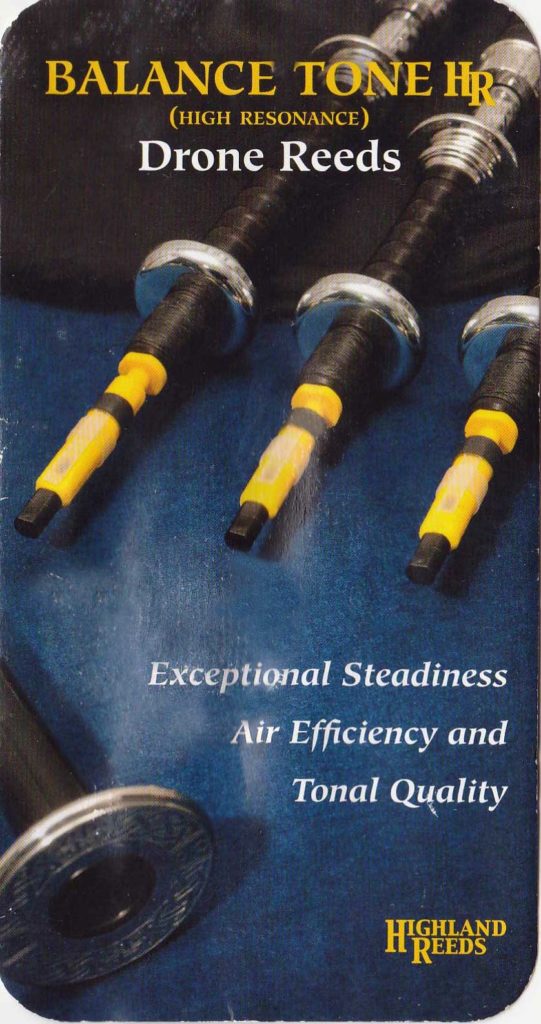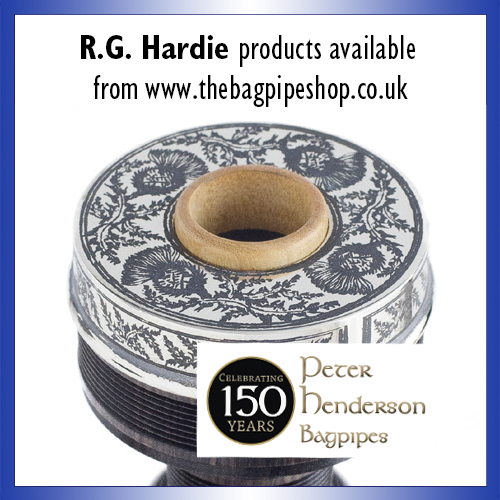
In February 2020, for their appearance and tone, I bought a used set of silver and faux ivory 1980 Kintail bagpipes. I then spent months trying to bring that tone properly to the surface, where I could be confident that they would still be near in tune whenever I picked them up.
There was no problem with my Henderson and Robertson bagpipes in achieving this situation very quickly with quality non-cane reeds. However, the Kintail pipe would not play ball in this manner and I recently moaned about this to a piper friend of mine. His response was to advise me to purchase a set of Bruce Hitchings’ HR3 drone reeds. These were, he said, the same reeds that both he and his current pupil now play. I eventually contacted Bruce and a set of his reeds duly arrived on Her Majesty Queen Elizabeth II’s 95th birthday.
I opened the case and removed a pamphlet hiding three yellow drone reeds that were resting individually in slightly springy hollows. A mysterious black plug sat at the top of each of the reeds and I also noted three curious circles on the reed body near the aperture. A single tiny groove in the shoulder above the reed seat could come in useful perhaps?
My first thought on seeing the bare, slippery looking plastic reed seat was, “How is hemp going to get a grip on that?” I began to wind wax-coated hemp onto the reed seat and found that there was no slippage whatsoever. On feeling the reed seat of the second tenor reed I discovered the surface to have a subtle roughness that my eyes couldn’t detect. Finally, the bass reed seat had its dose of hemp and my Kintails were ready to play.
It then dawned on me that perhaps the pamphlet might contain some useful information. On the reverse I found a number with which to register the product for a two-year warranty. I unfolded the pamphlet to discover a rich seam of information, including the proper way to hemp the reed seats. Everything on the reed serves a specific purpose. The black plug is an air control widget that is best left as it is for a full tone. The shoulder groove is no lucky accident either and serves to hold the hemp firmly when winding it around the reed seat. I also discovered I should have taken the top off the reed before hemping its lower half.

I headed towards the Duke of Wellington’s statue in Aldershot to hear the Kintails with their new reeds. I found suitable cover by a bush and put the pipes on my shoulder. Bass first. It was tuning too low so I pushed the reed body back up. The tenors were tuning too high, so I pushed their reed bodies down. Perfect.
There was an incredible, instant, steady, beautiful tone and volume from these reeds. I didn’t need to mess about with bridles; all that work has been done. It was quite an unbelievable experience. I played the 6/8 march, Glendaruel Highlanders and then called my friend to tell him of my success at finally getting the sound I want from my Kintails.
I immediately ordered two more sets of these reeds. I put one set into my Robertson drones and was in a very happy place indeed. They are dream, really. I wish someone had told me about these reeds years ago.
Postscript: Four months have now passed since I first had my successful encounter with these drone reeds and here are some further experiences I have had with them.
Each set of my drones has its own distinct sound and I have enjoyed finding that the HR3 reeds bring those particular sounds to their full ceilings. I cannot see past these drone reeds. They are simply fantastic.
My 1980 Kintail pipes are now my Scots Guards Association Pipe Band (SE England) set because their steadiness, tone and timbre are now of the required standard that, I think, matches their fine appearance. The band played at the Isle of Wight Highland Gathering this year and the sun beat down to test us pipers and our instruments. My bass drone reed did not like being cooked one tiny bit and to my surprise began to double tone. Up to this point, I never struck in my drones by touching the bag. I just blew the air in and tucked the bag under my arm. That’s how I find Bruce’s reeds can work and saves the risk of striking the bag in a wrong way that produces such a double tone. Too hot to mess about, I afterwards struck the bag in such a way to shut the bass drone off.
Back on the mainland, after a few more hot days I took the Kintail’s outside to see what was going on. It was still heatwave weather and checking the bridle on the bass, which now stopped of its own accord, I discovered that it was more pliant and even easier to move for adjustment purposes. I moved the bridle down a tad to free the spring of the blade. It was still stopping so I moved the bridle down quite a bit further this time and the bass certainly didn’t stop this time and was tuning a lot lower on the bottom tuning-pin. Now, here is the thing: if I had done this to any other bass reed I have ever played in my half century of having pipes on my shoulder, I would have suffered severe air loss through that reed. Not with Bruce’s reed, though. There was no difference that I could discern on that score while I kick started the reed back into action. It worked. I gradually moved the bridle back to find the sweet spot that had my bass drone tuning properly and, to my ear, singing once again.
3. My Henderson pipes were getting neglected and with a piping engagement coming up, I took them out for a blow … or so I thought. I put them on my shoulder to go through a few simple two-part tunes. Nothing. No drones. No chanter. Took the chanter out to mouth blow the reed and that was now okay. Mouth blew the drones and moved the bridles accordingly and we were into action. After a piobaireachd or two, the bridles went back to their original position with pipes sounding perfectly.
4. My Robertson pipes are just astonishing with these drone reeds. They have a different timbre to my Henderson and Kintail sets and I have not had to adjust bridles at this stage.
I can’t tell you how much it means to hear my Robertson and Henderson sets sounding so fantastic.
• Roger Huth is a former Scots Guards Pipe Major and is the holder of a British Army Pipe Major’s certificate (with rare AA pass). Roger won the Silver Medal at the 1984 Argyllshire Gathering and the Gillies Cup at the London Competition that year. He was the Pipe Major of the Scottish Piping Society of London in the mid-1980s and was an occasional contributor to the Piping Times.



